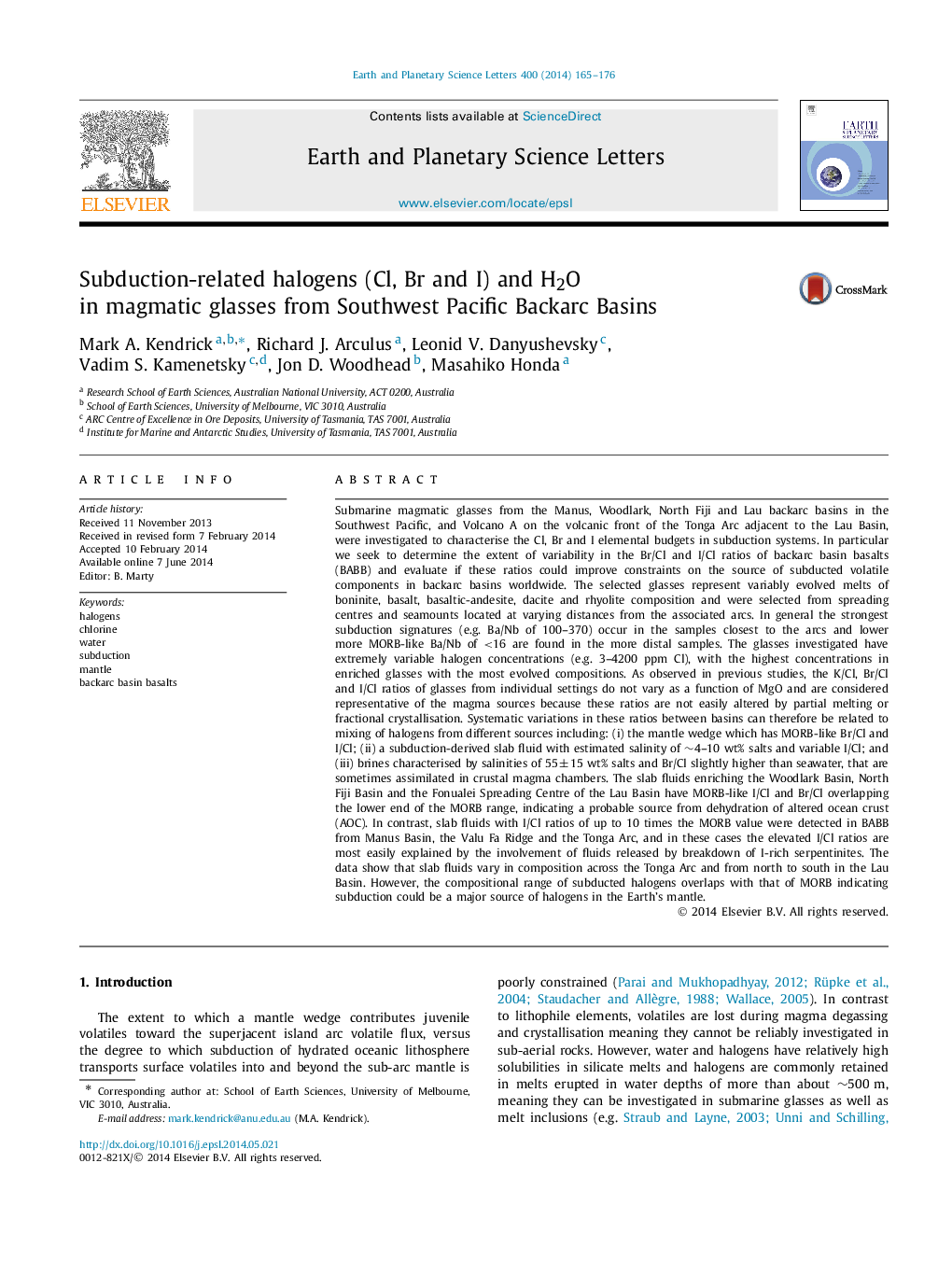| کد مقاله | کد نشریه | سال انتشار | مقاله انگلیسی | نسخه تمام متن |
|---|---|---|---|---|
| 6428768 | 1634756 | 2014 | 12 صفحه PDF | دانلود رایگان |

- We present Cl, Br, I and H2O data for submarine glasses from SW Pacific backarc basins.
- Br/Cl varies by only ±30%, demonstrating the geochemical similarity of these elements.
- Variation in I/Cl, K/Cl and H2O/Cl indicate: (1) mantle, (2) aqueous slab fluid and (3) assimilated brine components.
- Slab fluids in 3/5 locations are attributed to dehydration of altered ocean crust.
- Slab fluids with high I/Cl are attributed to breakdown of I-rich serpentinites.
Submarine magmatic glasses from the Manus, Woodlark, North Fiji and Lau backarc basins in the Southwest Pacific, and Volcano A on the volcanic front of the Tonga Arc adjacent to the Lau Basin, were investigated to characterise the Cl, Br and I elemental budgets in subduction systems. In particular we seek to determine the extent of variability in the Br/Cl and I/Cl ratios of backarc basin basalts (BABB) and evaluate if these ratios could improve constraints on the source of subducted volatile components in backarc basins worldwide. The selected glasses represent variably evolved melts of boninite, basalt, basaltic-andesite, dacite and rhyolite composition and were selected from spreading centres and seamounts located at varying distances from the associated arcs. In general the strongest subduction signatures (e.g. Ba/Nb of 100-370) occur in the samples closest to the arcs and lower more MORB-like Ba/Nb of <16 are found in the more distal samples. The glasses investigated have extremely variable halogen concentrations (e.g. 3-4200 ppm Cl), with the highest concentrations in enriched glasses with the most evolved compositions. As observed in previous studies, the K/Cl, Br/Cl and I/Cl ratios of glasses from individual settings do not vary as a function of MgO and are considered representative of the magma sources because these ratios are not easily altered by partial melting or fractional crystallisation. Systematic variations in these ratios between basins can therefore be related to mixing of halogens from different sources including: (i) the mantle wedge which has MORB-like Br/Cl and I/Cl; (ii) a subduction-derived slab fluid with estimated salinity of â¼4-10 wt% salts and variable I/Cl; and (iii) brines characterised by salinities of 55±15 wt% salts and Br/Cl slightly higher than seawater, that are sometimes assimilated in crustal magma chambers. The slab fluids enriching the Woodlark Basin, North Fiji Basin and the Fonualei Spreading Centre of the Lau Basin have MORB-like I/Cl and Br/Cl overlapping the lower end of the MORB range, indicating a probable source from dehydration of altered ocean crust (AOC). In contrast, slab fluids with I/Cl ratios of up to 10 times the MORB value were detected in BABB from Manus Basin, the Valu Fa Ridge and the Tonga Arc, and in these cases the elevated I/Cl ratios are most easily explained by the involvement of fluids released by breakdown of I-rich serpentinites. The data show that slab fluids vary in composition across the Tonga Arc and from north to south in the Lau Basin. However, the compositional range of subducted halogens overlaps with that of MORB indicating subduction could be a major source of halogens in the Earth's mantle.
Journal: Earth and Planetary Science Letters - Volume 400, 15 August 2014, Pages 165-176